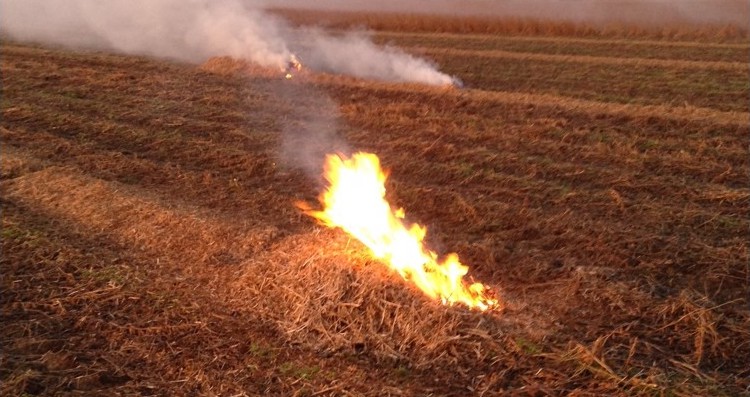January 11, 2021

Researchers at the University of Arkansas System Division of Agriculture have found a potential nonchemical option for growers to diminish the return of weed seed to the soil seedbank using harvest weed seed control (HWSC) mainly from narrow-windrow burning.
Commonly used in Australia, narrow-windrow burning poses a viable option to growers for commons weeds including: Palmer amaranth, barnyardgrass, johnsongrass, pitted morningglory, prickly sida, Italian ryegrass, sicklepod, velvetleaf, and hemp sesbania.
“There is a need to shift weed control programs toward strategies that involve the use of nonchemical approaches in conjunction with current herbicide programs if herbicides are to continue as a sustainable and effective option for growers,” said Jason Norsworthy, Distinguished Professor with the University of Arkansas Department of Crop, Soil and Environmental Sciences. Norsworthy’s research in narrow-windrow burning was published in a 2020 issue of Weed Technology.
The research
An experiment was conducted at the Altheimer Laboratory in Fayetteville, Ark., to determine the temperature and duration needed to kill the weed seeds listed above. Viability was initially determined for the seed of each weed species. Seed samples were then placed inside a high-fire kiln and subjected to 20 combinations of temperature and durations.
A field experiment was also conducted at the Northeast Research and Extension Center in Keiser, Ark., for two years in a production field of Credenz 4950LL soybean grown under irrigated conditions to assess the heat intensity and efficacy of killing the seeds of Palmer amaranth, barnyardgrass, johnsongrass, and pitted morningglory. Because the amount of soybean residue was expected to affect the heat intensity of burning, narrow windrows with increasing levels of residue were created by harvesting increasingly wider soybean plots. Seeds and ash from the burns were collected and germination was tested.
Palmer amaranth, barnyardgrass, hemp sesbania, sicklepod, velvetleaf, and Italian ryegrass seed survival were regressed using temperature and duration of exposure as explanatory variables. It was already established that the duration of exposure needed to kill weed seed decreases as temperature increases. Likewise, this study found that lengthening the exposure period reduced the temperature needed to achieve mortality of weed seeds.

Seed size
Seed size was found to impact on the amount of heat needed to kill each of the nine species. Small-seeded species such as Palmer amaranth and barnyardgrass showed complete mortality at lower temperatures for shorter times than species with larger seed size and hard seed coats such as pitted morningglory and sicklepod.
For the soybean harvest residue burning experiment, all seeds of Palmer amaranth, barnyardgrass, johnsongrass, and pitted morningglory were killed when the narrow windrows were burned. All seeds other than pitted morningglory were burned to ash. Pitted morningglory had the most resistant seeds and remained intact; however, these seeds were not viable.
Results
Given the validation of weed seed kill in narrow-windrow burning by the results from the kiln experiment, growers may consider using narrow-windrow burning to diminish the return of weed seed to the soil seedbank and thereby reduce selection for herbicide-resistant weeds. Herbicide-resistant weeds will continue to evolve and decrease the effectiveness of chemical control strategies if herbicide programs are not diversified. Harvest weed seed control, in particular narrow-windrow burning has been shown to be effective in decreasing the number of weed seed that returns to the soil seedbank in both wheat and soybean. The low cost of setting up a narrow-windrow burning chute and the effectiveness of this technique will make this a valuable option, as long as burning continues to be permissible in regions of the United States where farmland predominates.
The positive aspect of this strategy is that even if a farmer is already plagued with herbicide-resistant weeds, narrow-windrow burning will still destroy weed seed that would normally be returned to the soil seedbank and thus, over time, would reduce the number of weeds present in the field.
Source: University of Arkansas Division of Agriculture, which is solely responsible for the information provided and is wholly owned by the source. Informa Business Media and all its subsidiaries are not responsible for any of the content contained in this information asset.
You May Also Like




